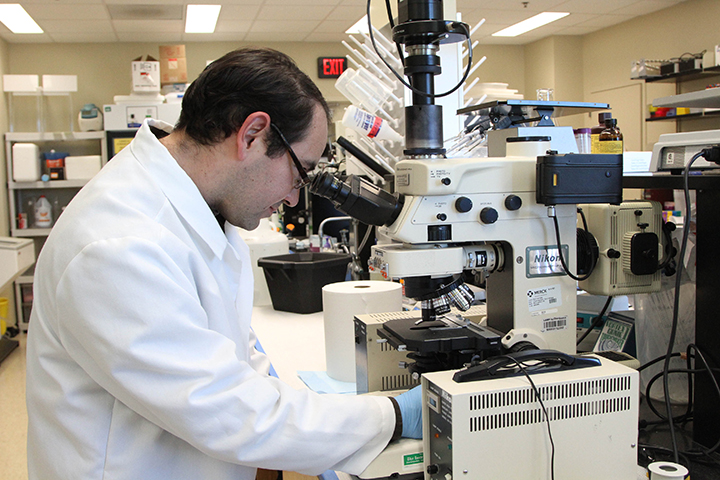Dr. Joaquin N. Lugo, Jr., professor of psychology and neuroscience, studies the link between seizures and autism Thursday in a lab.
Hannah Haseloff | Lariat Photographer
By Amanda Yarger
Reporter
Dr. Joaquin Lugo, Jr., assistant professor of psychology and neuroscience, received news late January that he earned a prestigious grant from the National Institutes of Health to study the neurological mechanisms that might connect developmental seizures and autism.
The $415,000 award, spanning three years, will help Lugo’s research team in discovering the effects of seizures on the mammalian target of rapamycin (mTOR) pathway — a neurological pathway involved with regulation and communication between neurons, Lugo said.
The National Institutes of Health presents awards to research proposals that demonstrate projects of high scientific caliber. Lugo’s research proposal had to provide the questions his study would cover and the process his team would use to identify the link between developmental seizures and autism.
“I think there’s a lot in the epilepsy community that can benefit the autism community and vice versa,” Lugo said. “I think they’re looking at them in isolation and I think they should look at them together. People can see the link, but they haven’t put them together.”
Lugo has studied epilepsy and autism during his graduate and post-doctoral work. He said the link between the two has not been fully researched and he hopes to clarify the link.
“Maybe we should think about this in the epilepsy field,” he said. “I think by this study if someone has a child who is epileptic and they’re very young, they might want to monitor to see if there’s autistic behaviors, to see if that’s something that happens.”
Although Lugo’s study will be performed on mice, the results of the study can eventually be translated to humans. Discovering how the research can impact real patients often intrigues students to join the research team.
“It’s fine to look at it in mice, but does it give them new ideas on how to think about patients?” he said. “Is this something that we’re seeing there? Should we be watching for it? Maybe there is a better connection than we thought there was.”
Lugo will lead a team of researchers that includes graduate and undergraduate students. Because he teaches upper-level neuroscience courses, his pool of candidates generally includes juniors and seniors who have a dedication to the neuroscience field and who are willing to have a time commitment to the lab — including summer vacations and school days.
“If they can come in and dedicate the time, they might be a good choice,” he said. “If they’re a hard worker and willing to do the work, I’m likely to choose them.”
Houston senior Tileena Smith is one of the undergraduate lab assistants in Lugo’s lab. She said she joined his team in fall 2014 because he was her favorite professor and she had a personal connection to Lugo’s research subject.
“I had a friend named Mary and she had a son who was a functioning autistic,” Smith said. “There are a lot of people who have connections to this.”
She said she enjoys assisting Lugo because of his calm demeanor in the classroom and lab, as well as the fact Lugo allows students to explore their interests in the lab while working side by side on his projects.
“He’s so calm and doesn’t get mad when we do something wrong,” she said. “He explains why it was wrong and how to improve.”
Waco senior Conner Reynolds said he joined Lugo’s research team last June because of a personal connection as well.
“My sister has Asperger’s Syndrome,” he said. “At first I thought I was just getting into a lab that would help me out and show me the ropes, but what’s really made me stay is [Lugo’s] unparalleled mentorship. He doesn’t just want you to come in and work in the lab. He wants you to come in and be a collaborator.”
